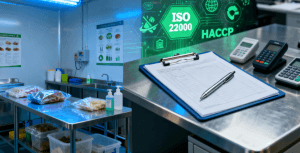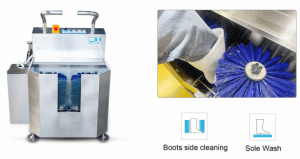In the high-stakes world of food processing, safety isn’t just a goal – it’s the absolute foundation. Every step, every surface, and crucially, every person entering the production area carries a responsibility. Before you step foot onto the workshop floor, there’s a non-negotiable ritual: meticulous hygiene for both your hands and boots.This isn’t mere procedure; it’s your primary shield against contamination and a core pillar of consumer trust.
Why This Dual Hygiene Barrier is Non-Negotiable
Our hands are constant workers, touching surfaces, equipment, and sometimes our own clothing. Boots traverse various areas, potentially picking up debris, dust, or microorganisms. Without rigorous hygiene:
1. Pathogens Travel: Bacteria, viruses, and allergens can hitch a ride on skin or footwear.
2. Product Contamination Risk Skyrockets: The very food we produce becomes vulnerable.
3. Brand Reputation is Jeopardized: A single lapse can have devastating consequences.
4. Regulatory Compliance Fails: Strict food safety standards (like GMPs, HACCP, FSMA) demand these controls.
The Mandatory Pre-Workshop Hygiene Protocol:
1. Hand Hygiene: Wash, Dry, Disinfect (The Triple Shield)
Wash: Thoroughly wet hands with clean, running water. Apply soap and scrub vigorously for at least 20 seconds. Pay meticulous attention to all surfaces: palms, backs, between fingers, under nails, and wrists. Rinse completely under running water.
Dry: Use single-use paper towels or a dedicated, clean air dryer. Damp hands spread germs more easily than dry ones. Never use aprons or clothing.
Disinfect: Apply an approved alcohol-based hand sanitizer (following manufacturer’s instructions) to completely dry hands. Rub thoroughly until dry. This step destroys microorganisms that washing might not remove.
2. Boot Hygiene: Clean Before You Walk In
Clean: Before entering the hygiene station or designated boot wash area, remove any visible debris (dirt, food particles, packaging bits) from your boots using a dedicated brush or scraper. This prevents contaminating the cleaning/disinfection area.
Disinfect: Step onto the designated boot scrubber or into the boot wash trough. Use the provided brushes and approved boot disinfectant solution. Scrub all surfaces of the boots – soles, sides, heels, and uppers – thoroughly. Ensure contact time requirements for the disinfectant are met. Rinse if required by the disinfectant instructions.
Dry (if applicable): Some procedures may require boots to be dried before entry. Follow site-specific protocols.
Only Then: Enter the Workshop
Only after both hand hygiene (Wash, Dry, Disinfect) and boot cleaning/disinfection are fully completed should you proceed through the final entry point into the production workshop. This sequence is critical. Touching a door handle or sanitized boot after washing your hands but before they are disinfected, or entering with unclean boots, undermines the entire process.
This is More Than a Rule – It’s a Culture
Adhering to this protocol isn’t just about ticking a box. It demonstrates:
Personal Responsibility: You are actively protecting the product and consumers.
Team Commitment: Every single employee plays a vital role in collective food safety.
Professionalism: Upholding the highest standards defines our work ethic.
Management’s Role: Enable and Enforce
Provide: Ensure well-maintained, fully stocked hand washing stations (soap, paper towels, sanitizer), functional boot washers with correct disinfectant, and clear signage.
Train: Regularly reinforce why this is critical and how to do it correctly.
Audit: Monitor compliance consistently and address lapses immediately.
Conclusion: Hygiene First, Always
“Do the Hands and Boots Hygiene, Then Enter the Workshop” is the golden rule at our facility. It’s the simplest yet most powerful action we take daily to ensure the safety and quality of every product that leaves our line. Let’s commit to this essential practice every single time, without exception. Our consumers, our reputation, and our shared success depend on it.




